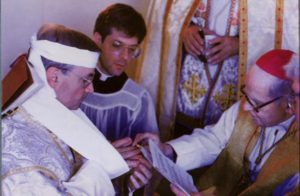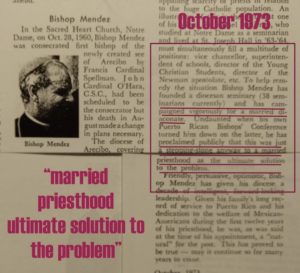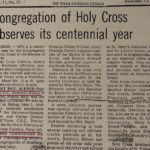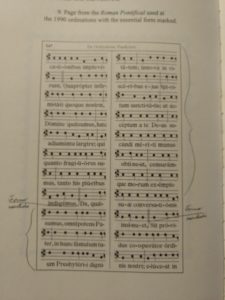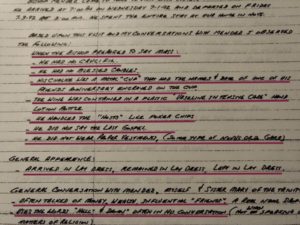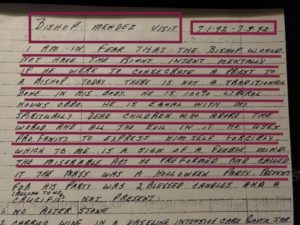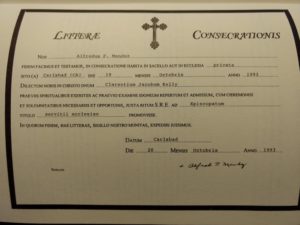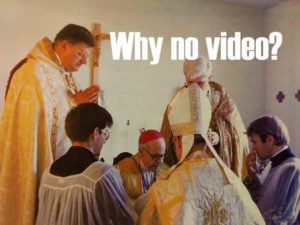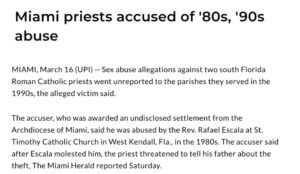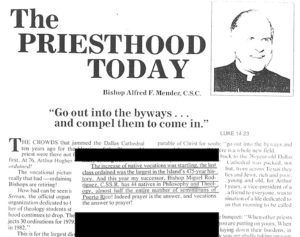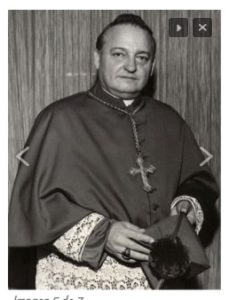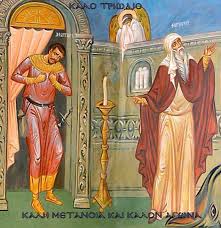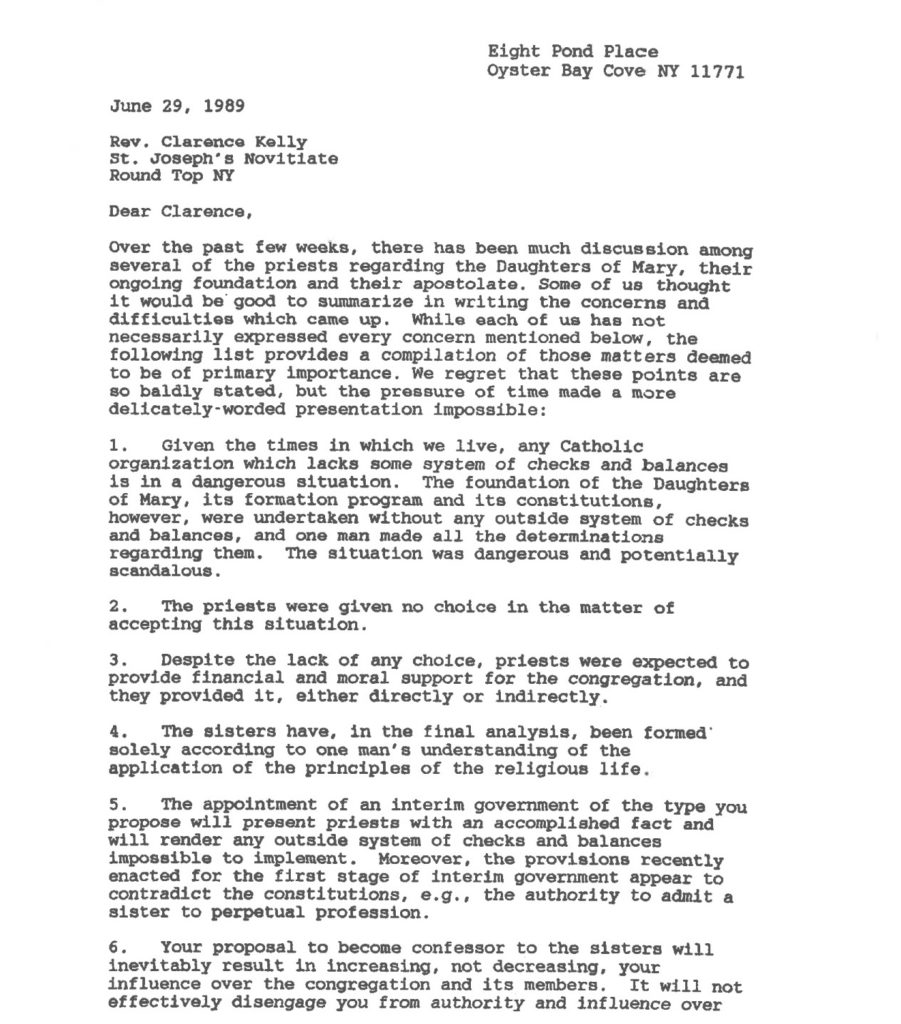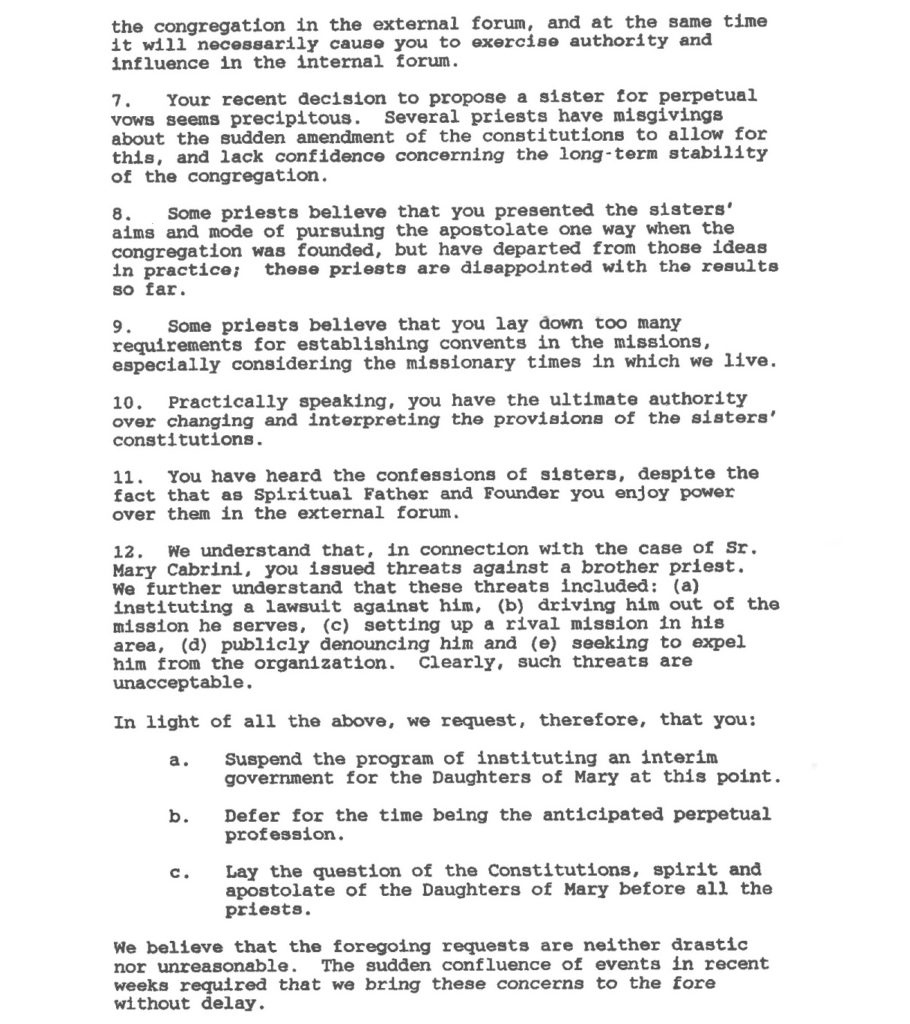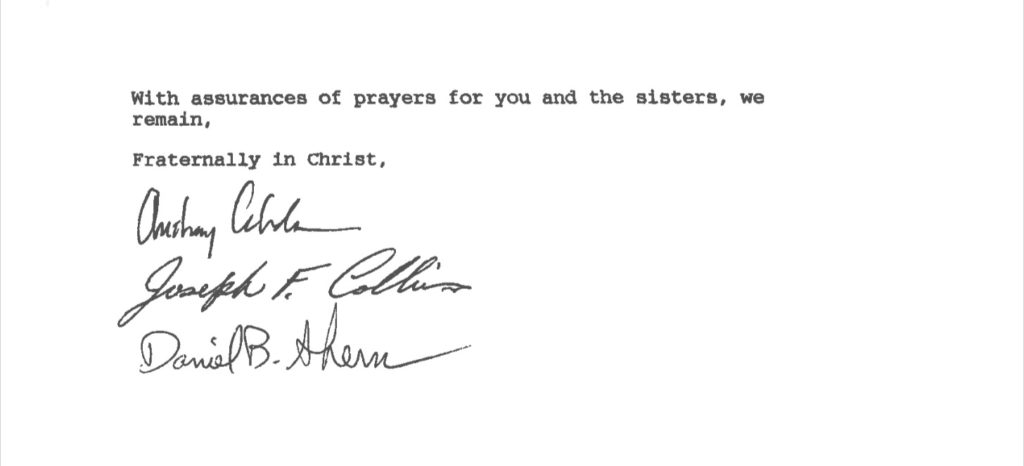QUESTION: I recently came across a picture of Bishop Clarence Kelly wearing a stole over a purple shoulder cape with a black cassock underneath, and I remember seeing old photos of Bishop Francis Schuckardt dressed just the same way. Were they both correctly dressed?
Also, I’ve seen newsletters from SSPX and several other traditionalist organizations that show their bishops offering Pontifical High Mass or conferring Holy Orders, but in some cases they don’t seem to be wearing all the proper episcopal vestments either.
What gives? Am I just being too picky? Are some of the bishop’s vestments optional? Or are they required?
RESPONSE: The vestments that a bishop is supposed to wear for any solemn liturgical function are all minutely regulated by the rubrics — the laws and norms that govern how the Sacred Liturgy must be performed.
According to these norms, Bishops Kelly and Schuckardt were indeed both dressed incorrectly, as were the other bishops depicted in the newsletters you sent along.
The rubrics for Low Mass do not leave me, a priest, free to omit wearing an amice or a maniple. So too, the rubrics for Pontifical High Mass and ordinations do not leave a bishop free to perform these functions without wearing all the prescribed vestments.
Since the rubrics that govern ceremonies celebrated by a bishop are highly detailed and complex, some traditionalist laymen, and even some clergymen, affect the attitude that such matters are trivial and not worth worrying about.
This, alas, betrays not only a contempt for a vast body of liturgical legislation developed over centuries, but also an ignorance of the spirit of the Sacred Liturgy. The Church’s ideal for public worship is not the rapid Low Mass, but rites that are conducted with as much solemnity and splendor as possible. The high point for this occurs when a bishop celebrates Pontifical High Mass.
Even non-Catholics acknowledge its singular beauty and significance. The English art critic John Ruskin (1819–1900) said that the apex of all Western Civilization was Pontifical High Mass in a Gothic cathedral.
Before turning to the specific “wardrobe malfunctions” of the traditionalist prelates depicted in the newsletters mentioned, I will define some terms, and then list the principal elements of correct dress prescribed for a bishop by the Church’s liturgical legislation (the Caeremoniale Episcoporum and Roman decrees) and approved commentaries.
I. What is Pontifical Mass?
————————————————————-
The general term “Pontifical Mass” refers to a Mass celebrated by a bishop that follows special rubrics which add to the dignity and solemnity of the celebration. It is called “Pontifical” not because the rite is somehow connected with the pope, but rather because it is celebrated by a pontifex — the Latin term for a high priest, which the rubrics sometimes use to refer to a bishop or prelate.
There are two usual forms of Pontifical Mass properly speaking:
(1) Pontifical High Mass: The bishop is assisted by at least 18 ministers, including an Assistant Priest, Deacon and Subdeacon.
The first part of Pontifical High Mass takes place not at the altar, but at a chair in the sanctuary (either at a throne on the Gospel side or at a backless chair called a faldstool on the Epistle side). A special book called the Canon Episcopale takes the place of the altar cards used by a priest, a hand-candle (bugia) is held next to a book when a bishop reads from it, and there are five servers to handle the additional items required (book, hand-candle, miter, crozier and the gremiale, a small apron for protecting the bishop’s vestments).
The bishop is vested in his “pontificals,” that is, not only the usual vestments that a priest wears for celebrating Mass, but also additional vestments proper to his rank that in one way or another signify the fullness of the priesthood that he possesses.
(Readers can get some idea of the complexity of Pontifical High Mass by viewing the DVD of Bishop Dolan’s 1993 consecration to the episcopate.)
(2) Pontifical Low Mass: The bishop is assisted by one or two chaplains (who stand next to him at the altar), two acolytes, four torchbearers, and (if necessary) a Master of Ceremonies.
The rite is conducted at the altar, and for the most part, follows the rubrics for Low Mass celebrated by a simple priest. The Canon Episcopale and the hand-candle are used, and if one of the chaplains is a priest, he assists the bishop by performing some functions of a deacon.
In addition to the Mass vestments worn by a simple priest, the bishop wears a purple zucchetto (skull-cap), pectoral cross and his everyday ring. If a bishop confers Major Orders during Pontifical Low Mass, however, he obliged to wear the same vestments as prescribed for Pontifical High Mass.
II. The Bishop’s Choir Dress.
————————————————————-
A bishop who is to celebrate Pontifical High Mass ceremonially recites the prayers of preparation for Mass and is solemnly vested for Mass by the deacon and subdeacon, either in the sacristy or in the sanctuary of the church itself.
For this, the bishop does not wear his usual black cassock trimmed with red. Rather, the rubrics assume that he arrives for the vesting ceremony wearing the more formal “choir habit,” which for a bishop consists of the following:
1. Purple choir cassock.
2. Purple choir cincture with two tassels.
3. Zuchetto. (Skullcap)
4. Rochet. (A knee-length garment of lace and linen with close-fitting sleeves trimmed in red. It is a sign of prelacy.)
5. Purple cape. (The mozzetta for an Ordinary, the mantelletta for other bishops.)
6. Pectoral cross on a green and gold cord.
7. Ring.
8. Purple socks. (Yes, purple socks!)
9. Roman clerical shoes with buckles.
10. Purple biretta.
In past ages, bishops wore this uniform all the time, until in 1870 Pius IX instituted a less cumbersome everyday uniform for bishops (called the habitum pianum). The Church nevertheless retained the more formal choir habit for solemn occasions.
III. Vestments Required for Pontifical Mass.
———————————————————————-
Attired in his choir habit, the bishop reads the Psalms of Preparation, during which the Master of Ceremonies invests the bishop with the special footgear (items 1, 2). The bishop then recites several prayers that recount the symbolism of the vestments and has his hands washed. After this the Deacon, Subdeacon and Assistant Priest solemnly vest him with the rest of the items. Here is what is required:
1. Buskins. (Loose-fitting leggings in the liturgical color of the day that the Master of Ceremonies puts on the bishop’s legs and then ties.)
2. Sandals. (Special fabric shoes, also in the color of the day, that the Master of Ceremonies puts on over the bishop’s buskins.)
3. Amice.
4. Alb.
5. Cincture.
6. Pectoral cross on a green and gold cord. (Strength against enemies; the victories of the Cross and the martyrs.)
7. Tunic. (Made of light silk, the color of the day. This is the garment of a subdeacon, symbolizing joy.)
8. Dalmatic. (Also of light silk, and slightly shorter than the tunic. This is the garment of a deacon, symbolizing salvation and justice.)
9. Gloves. (Color of the day, embroidered with crosses. Acceptance of the Sacrifice)
10. Chasuble.
11. Miter. (Two types are used at the same Mass: a precious miter with jewels and gold embroidery that is worn in procession and for shorter periods of time during Mass, and a golden miter that is worn when the bishop sits for longer periods of time. Helmet of salvation against the snares of the enemy.)
12. Pontifical ring. (Sevenfold gift of the Holy Ghost.)
13. Crozier.
14. Maniple. (Put on in the sanctuary at the prayer Indulgentiam.)
The symbolism of some items is self-evident, but three in particular merit an additional comment:
(a) Buskins and Sandals. The bishop’s feet are vested, according to the medieval liturgist Durandus, as an allusion to the verse that the liturgy applies to the Apostles themselves: “How beautiful are the feet of those who preach the Gospel of peace.” (Nabuco, Ius Pont., 179)
(b) Tunic and Dalmatic. Bishops at Pontifical Mass must wear the vestments of a subdeacon and deacon because in bishops, said the medieval liturgist Durandus, “the degrees of all the Major Orders are most eminently present.” (Nabuco, Ius Pont., 182)
(c) Gloves. The vesting prayer for the gloves contains an Old Testament allusion: Jacob covering his hands when he presented his offering to his father to obtain a blessing; the bishop prays that through his sacrifice he may likewise receive a blessing, that of divine grace.
Above and beyond the particular symbolism of each vestment, moreover, the vestments for Pontifical High Mass represent another truth when taken together. Unlike a simple priest vested for Mass, a bishop who pontificates is “covered” from head to foot, immersed, as it were, in the High Priesthood of Jesus Christ.
One bishop told me that, the first time he was being vested for Pontifical Mass, he felt like a lamb being dressed for slaughter.
IV. Some Dress Code Violations
————————————————————-
Here are some of the more obvious dress code violations perpetrated by the various traditionalist bishops depicted in the newsletters I mentioned:
(a) Not wearing the tunic and dalmatic to confer Major Orders. “A bishop,” says the rubricist Nabuco “cannot confer sacred orders without pontifical vestments.” (Pont. Rom. Exp. 1:160)
Hence when a bishop must confer Major Orders (subdiaconate, diaconate, priesthood, episcopacy) but cannot celebrate Pontifical High Mass, he may celebrate Pontifical Low Mass, but he must wear all the pontifical vestments, including the pontifical tunic and dalmatic. (See Nabuco, Pont. Rom. Exp. 1:165; 1:261, 231)
When a bishop confers the sacred orders of subdiaconate, diaconate, priesthood or episcopacy, he is exercising the fullness of the priesthood. Omitting to wear all the vestments that symbolize his power is a glaring fault.
(b) Not wearing the pontifical buskins and sandals. Whenever he wears the pontifical gloves, a bishop is also required to wear this ceremonial footgear. Nabuco explains that the covering of the hands and feet is “correlative” and together they form “one vestment.” (Ius Pont., 179)
No matter what rubrics a traditionalist bishop follows — Pius X, Pius XII or John XXIII — all three require a bishop to wear the buskins and sandals (1) whenever he celebrates Pontifical High Mass, and (2) even when he confers Major Orders (subdiaconate, diaconate, priesthood, episcopate) at Pontifical Low Mass.
The John XXIII rubrics allow the bishop to put the buskins and sandals on in his room. The old rubrics prescribe that the Master of Ceremonies puts them on the bishop as he recites the Prayers of Preparation in the sacristy.
Omitting the required footgear is a serious fault, moreover, because “all tradition bears witness that the use of such vestments in solemn Masses and other sacred functions is most ancient.” (Nabuco, Ius Pont., 179)
(c) Wearing gloves at the end of Pontifical Mass. After the bishop has read the Offertory Verse and is seated, the deacon and subdeacon remove his gloves.
The bishop does not wear them again during Pontifical Mass, and “he must not put them on again after Communion.” (Le Vavasseur, Fonctions Pont., 1:26; SRC Decr. 3213 ad 6)
The only exception was when the Ordinary of a Diocese granted the Apostolic Blessing and Indulgence from the throne after the Last Gospel. (SRC Decr. 3605 ad 9)
(d) Wearing a stole over the mozzetta or mantelletta. One of these two purple capes is a part of a bishop’s choir habit (see section II). It is common to see traditionalist bishops of various persuasions wearing stoles over their capes when they impose hands at an ordination conferred by another bishop.
Though it is widespread, the practice is completely incorrect: “The Sovereign Pontiff is the only Prelate who may wear a stole over his cape,” (Nainfa, Costume of Prelates, 231), and specifically, “A stole should never be worn over the mantelletta.” (McCloud, Clerical Dress, 97)
The underlying reason is that the choir habit is worn primarily for formal assistance at the Divine Office, while the stole is principally a liturgical vestment worn for conferring sacraments and bestowing blessings.
At an ordination a prelate who is assisting in the sanctuary simply imposes hands while wearing his choir habit.
(e) Combining the choir habit and the ordinary cassock. This offense improperly combines two forms of clerical dress. It is as odd as a priest wearing a surplice over his clerical suit.
It violates what liturgical books call “the rule of harmony” or “the law of equilibrium.” According to this rule, “the main parts of a Prelate’s costume should match one another in material as well as in color. For instance, a Bishop should not wear a purple mozzetta over a black cassock.” (Nainfa, 237)
So the suspicion of our correspondent was correct: Bishop Kelly and his nemesis were improperly attired.
But in the matter of two-tone habits and incorrectly worn stoles, these two prelates had plenty of company: Archbishop Lefebvre regularly wore this mismatched outfit when I was in SSPX in the 1970s, and the bishops he consecrated all seem to have continued this “tradition.”
* * * * *
As regards any traditional Catholic bishop, it is indeed “now the brightness of souls rather than splendor of raiment that commends the pontifical glory unto us,” as the Preface for the Rite of Episcopal Consecration so eloquently proclaims.
That said, however, the Church herself established and minutely regulated a complex system of visible, material signs that point to the invisible, spiritual realities of a bishop’s powers. Those few real bishops who now possess these powers should be meticulous in learning and applying the rules that the Church’s law and traditions impose upon them when they exercise the fullness of their priesthood.
On this point, the bishops would do well, perhaps, to ponder the words of St. Theresa of Avila:
Know this: It is by very little breaches of regularity that the devil succeeds in introducing the greatest abuses. May you never end up saying: This is nothing, this is an exaggeration. (Foundations, 29)
Today, in liturgy as in theology, a casual or even contemptuous attitude towards the rules prevails in many traditionalist circles. It is often, alas, the product of ignorance, laziness or pride.
It is true that we faithful Catholics are far from the day when we could everywhere perform the Sacred Liturgy with the splendor that it truly deserves. But that may well be because most of us are also far from saying with St. Theresa:
I would give up my life a thousand times, not only for each of the truths of Sacred Scripture, but even more for the least of the ceremonies of the Church. (Life 33:3)
—————————
BIBLIOGRAPHY
CLEMENT VII. Caeremoniale Episcoporum. Ed. Malines: Dessain 1906.
LE VAVASSEUR, L, & J. Haegy. Les Fonctions Pontificales selon le Rit Romain, 6th ed. Paris: Gabalda 1932. 2 vols.
MISSALE ROMANUM. “Orationes dicendae ab Episcopo quando in pontificalibus celebrat.”
MCCLOUD, Henry J. Clerical Dress and Insignia of the Roman Catholic Church. Milwaukee: Bruce 1948.
NABUCO, Joachim. Ius Pontificalium. Paris: Desclée n.d.
_______, Pontificalis Romani Expositio Juridico-Practica. New York: Benziger 1944. 3 vols.
NAINFA, John A. Costume of Prelates of the Catholic Church. Baltimore: Murphy, 1926.
PONTIFICALE ROMANUM. “De Consecratione electi in Episcopum.”
SC RITES (“SRC”). Decreta Authentica. Rome: Polyglott 1898. 7 vols.
_______. Decree 3213. Olmucen. 5 March 1870.
_______. Decree 3605. Neapolitana. 23 February 1884.
